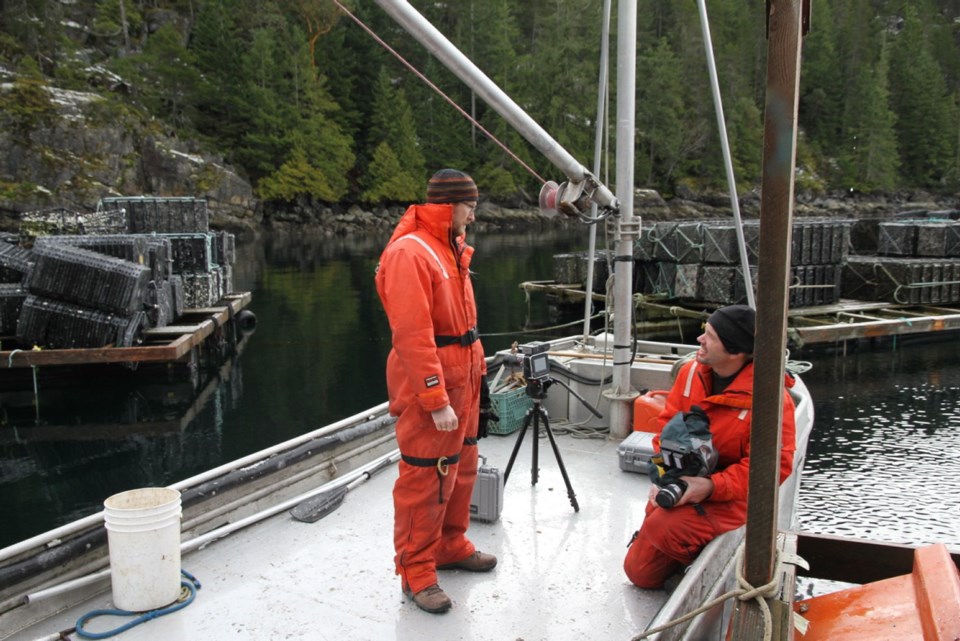What: Reaching Blue: Finding Hope Beneath the Surface
Where: Cinecenta, UVic
When: Friday, 7:30 p.m.
Info: 250-721-8365
You won’t hear any complaints about rush hour on the Salish Sea from Jay Donaldson.
“When the traffic’s bad, you’ll get held up by a pod of dolphins or a couple of orcas cruising by,” says the B.C. oyster farmer with a smile, casually reflecting on his coastal lifestyle off Quadra Island.
“You’ve just got to enjoy the show for a while.”
Donaldson is one of the subjects who weigh in on the wonders of the Salish Sea and the importance of respecting the world’s oceans in Reaching Blue: Finding Hope Beneath the Surface, a new documentary from director Ian Hinkle and producer Andrew Robertson. It’s being screened Friday as part of the Canadian Ocean Film program at Cinecenta, with both Victoria-based filmmakers in attendance.
Port Townsend-based writer Brett Nunn, marine biologist Anne Salomon, Kate Moran, CEO of Victoria-based Ocean Networks Canada, and Steve Pocock, owner-operator of Quadra Island’s Sawmill Bay Shellfish Co., also shed light on the dramatic changes taking place in local waters and worldwide and what it will take to turn the tide before it’s too late, with hope found in stories from the past.
“Everyone who lives on this planet is connected by these bodies of water,” observes Nunn. “When you live on the edge of the Salish Sea you’re reminded of that.”
And while most of what we know about the world’s oceans is based on surface satellite images, we need to look far beneath the surface to really understand it, Moran says.
Inspired by the international focus of a deep-sea project led by Ocean Networks Canada, the University of Victoria initiative, Robertson spent a month at sea on an expedition with Schmidt Ocean Institute’s research vessel Falkor.
The filmmakers crowd-sourced ocean footage from 15 cinematographers from B.C. and Washington state to contribute undersea and above-water imagery for their visually striking 20-minute film. It includes footage from deep-sea submarines, high-tech ocean research vessels and drone cameras flying through a coastal rainforest to illustrate ecological changes.
A major concern is the escalating acidification of the ocean that, on a local level, poses an unknown future for oysters and other coastal seafood stocks.
Reaching Blue also features striking footage of the Western Flyer, the wooden fishing boat novelist John Steinbeck chartered in 1940 with his friend, a biologist.
Built from Douglas fir from the south end of the Salish Sea, the decaying vessel is now “a rotting relic” sitting in the back of a boatyard in Port Townsend, notes Nunn.
“In 1966, Steinbeck called for the establishment of a kind of NASA of the oceans and we’re still not there yet,” laments Hinkle, whose other films include The Living Coast and 30-Mile-Dive. “We know more about Mars than we do about the oceans on planet Earth. We’ve mapped Mars better than our oceans … we have the opportunity now, and new advances in technology.”
The motivation for the filmmakers’ new project had as much to do with the welfare of the younger generation as their love for the ocean.
“I have a 10-year-old daughter, so when I look at issues like this, I’m inspired to share stories that could help make a difference,” Hinkle said. “I also grew up on the Salish Sea and although I’ve worked on films in different places, the ocean always draws me back. More and more, I see that without a healthy ocean we have no life on planet Earth.”
Another reason, he said, was to underscore the connection between local waters and the ocean globally.
“You can’t fence off the Pacific,” he said. “We talked to an oyster farmer because he’s seen changes firsthand that are drastically affecting the industry in B.C., but it’s not just a local problem. It’s a sign there are greater changes that we need to understand. When you’re facing issues like climate change and if it’s affecting the food web, there’s an urgent need to do something about it.”
Reaching audiences today is dramatically different from 20 years ago, he adds, explaining why there is also a web version and an hour-long version airing Sept. 6 on CBC as part of the Absolutely Canada series. Screenings are also taking place at Vancouver’s Cinematheque and the Vancouver Public Library, and in cities including Prince Rupert, Halifax and Toronto.
“In four months we made a film that, in the past, would have taken a lot longer,” said Hinkle, explaining why they used crowd-sourced footage. “We can’t just go out on a boat and wait to find a breaching whale. It’s a new world of filmmaking. There are so many talented people we know out there with great cameras.”



